Black Snakes in Illinois
#mobileSnakeQuizControls { overflow: hidden; text-overflow: ellipsis; white-space: nowrap; }
@media (min-width: 481px) {
.mobile-top-content {
display: none;
}
}
#mobileTopContentCTACarouselControls { overflow: hidden; text-overflow: ellipsis; white-space: nowrap; }
.mobile-top-content .more { color: #fff; }
.mobile-top-content a { color: #fff; text-decoration: underline; }
.mobile-top-content a:hover { color: #fff; text-decoration: underline; }
@media (max-width: 480px) {
.mobile-top-content {
background-color: #06a10b;
color: #fff;
text-align: center;
/*height: 60px;
padding-top:5px;*/
font-size:80%;
/* display: block; */
margin: 0px -30px;
}
}
There are 40 species of snakes currently recognized in Illinois. Of those 40 species, 11 are listed as threatened or endangered. But what about black snakes in Illinois? There are actually seven species of black snakes in Illinois. Like all snakes, these species are cold-blooded and rely on the sun’s warmth to warm their bodies. They range in size from just over a foot long to well over six feet. While none of the black snakes in Illinois have venom, they’re still wild animals and should be respected and left alone.
Let’s take a closer look at the seven species of black snakes in Illinois. Then, we’ll discuss what you should do if you come across a snake in Illinois.
7. Black Racer (Coluber constrictor)
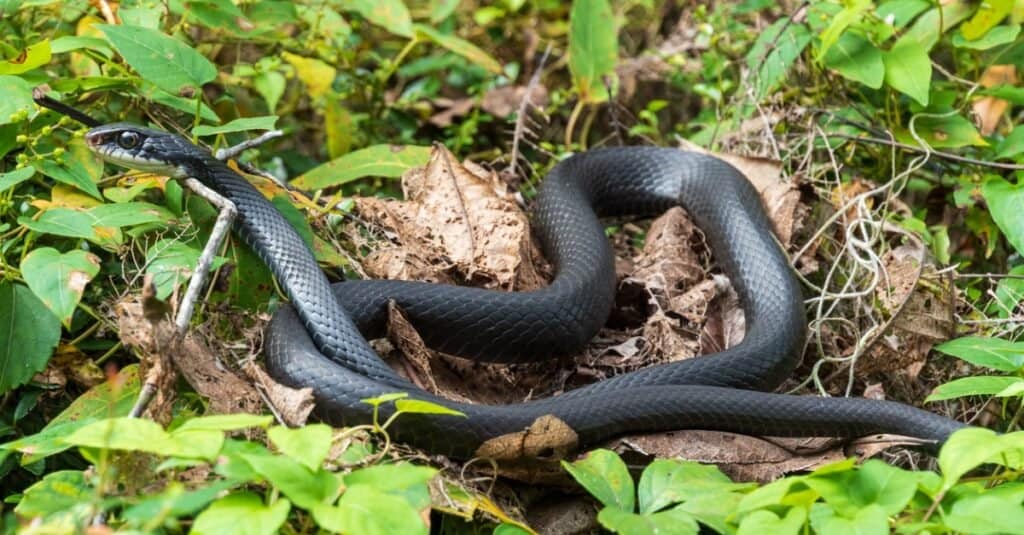
iStock.com/Sunshower Shots
button.pulse {
transform: scale(1); animation: pulse 2s infinite;
box-shadow: 0 0 0 0 rgba(11, 247, 25, 1);
}
@keyframes pulse {
0% { transform: scale(0.90); box-shadow: 0 0 0 0 rgba(11, 247, 25, 0.5); }
60% { transform: scale(1); box-shadow: 0 0 0 15px rgba(11, 247, 25, 0); }
100% { transform: scale(0.90); box-shadow: 0 0 0 0 rgba(11, 247, 25, 0); }
}
Black racers grow up to five feet long and have slender, thin bodies. They’re common throughout the entire eastern half of the United States and even live in Florida. Black racers are sometimes mistaken for black rat snakes or black kingsnakes. They’re almost entirely black or dark gray, with the exception of some white coloring at the throat. Juvenile black racers actually aren’t black snakes in Illinois—they’re light gray with brown patterning.
Black racer snakes live anywhere they can find food. Their favorite prey are birds, rodents, lizards, snakes, and even insects.
6. Ringneck Snake (Diadophis punctatus)
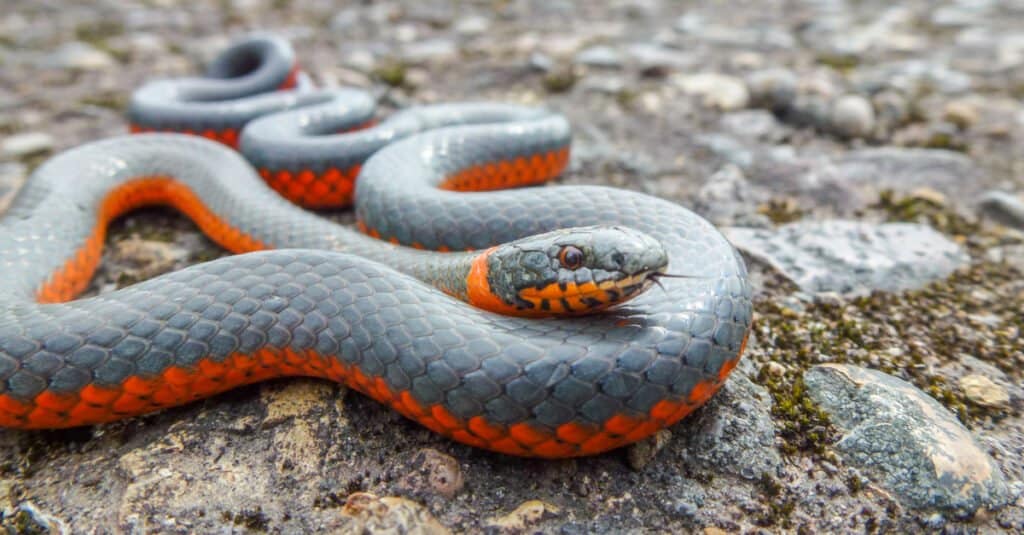
Tom Fenske/Shutterstock.com
Ringneck snakes range in color from gray to black, with yellow to tan bellies. They’re one of the black snakes in Illinois. But, as you might have guessed, they get their name from the brightly colored ring around their neck. Ringneck snakes have yellow bands just behind their heads, but other than that, their backs are all black or gray.
These snakes are so small you might never notice them, with the biggest reaching only 15 inches long. They live just about anywhere they can find small prey, including forests, rocky hillsides, grasslands, or riverine environments. They’re not a threat to humans, though they use a weak venom for hunting prey like mice and lizards.
5. Western Mud Snake (Farancia abacura)
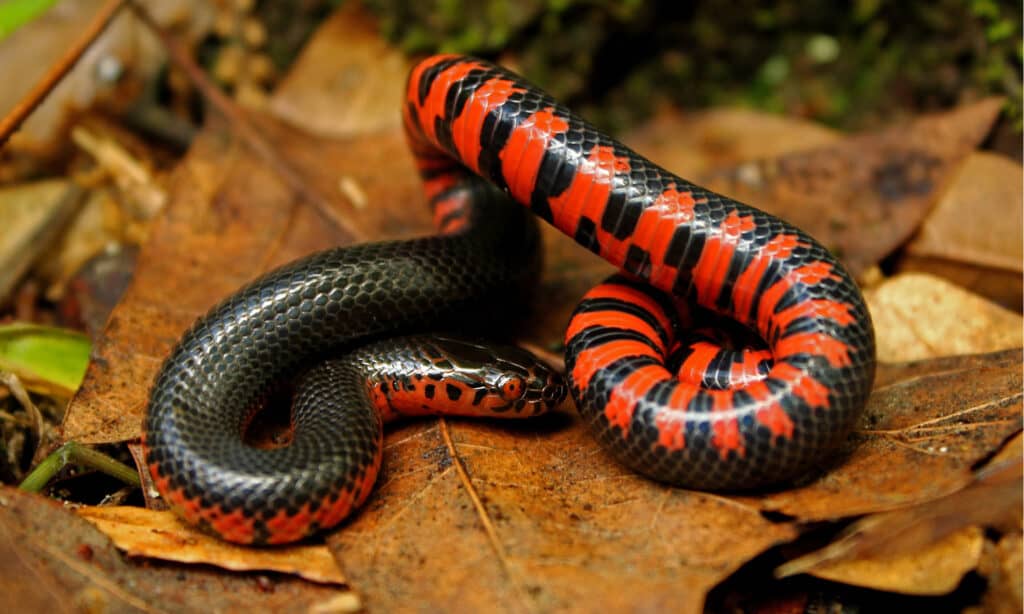
Thesigner_2696/Shutterstock.com
Western mud snakes live throughout the southeastern United States. They’re found only in the extreme southern part of Illinois. Mud snakes spend most of their time in the water, either in swamps, slow-moving rivers, lakes, wetlands, or ponds. They prefer areas with lots of aquatic plantlife to hide in; humans rarely get the chance to see these beautiful, elusive snakes.
Western mud snakes are one of the black snakes in Illinois, but they’re not entirely black. Both adults and juveniles have all black backs, with red to pink bellies and sides. Young mud snakes have bright red, striped bellies, while adults tend more towards pink. These snakes eat mostly amphibians, like salamanders, frogs, toads, and tadpoles.
4. Black Kingsnake (Lampropeltis getula)

Matt Jeppson/Shutterstock.com
Black kingsnakes grow to an average length of 3-4 feet. They’re almost entirely black, except for thin, white bands that run down their bodies. They prefer living in grasslands, shrublands, or areas bordering wetlands or streams. Black kingsnakes aren’t venomous, but that doesn’t stop them from consuming other venomous snakes.
These snakes only occupy the southern half of Illinois. They’re sometimes mistaken for other black snakes in Illinois. But, only the black kingsnake bears the distinctive pale bands around its body.
3. Black Rat Snake (Pantherophis obsoletus)
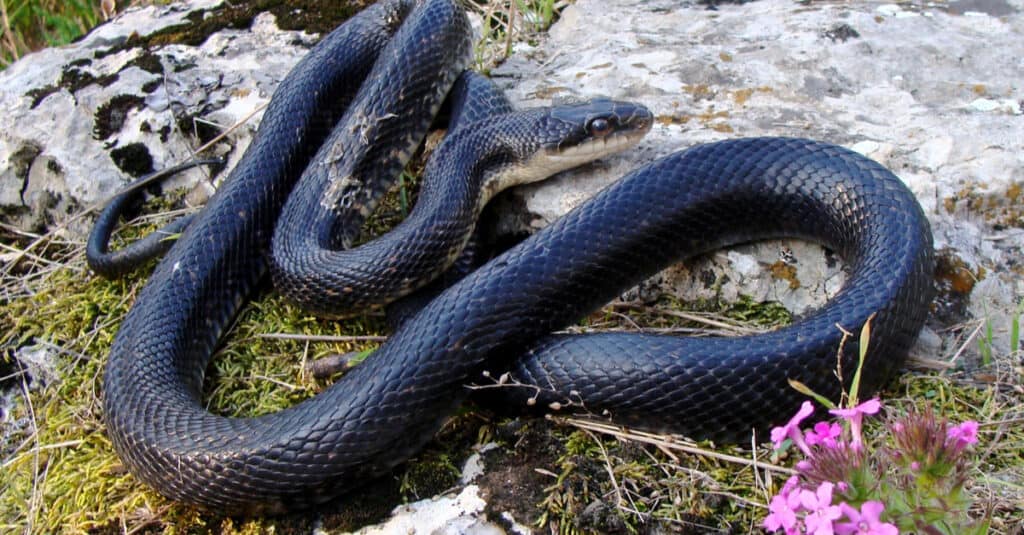
Matt Jeppson/Shutterstock.com
One of the larger black snakes in Illinois, black rat snakes grow up to six feet long. But don’t be afraid of them—they’re not venomous and have no interest in biting humans. Instead, as you might have guessed from their name, they prey mainly on rodents, like rats and mice.
Black rat snakes live throughout the entire eastern United States. In Illinois, they prefer forests, floodplains, and the margins of suburban areas.
2. Graham’s Crayfish Snake (Regina grahamii)
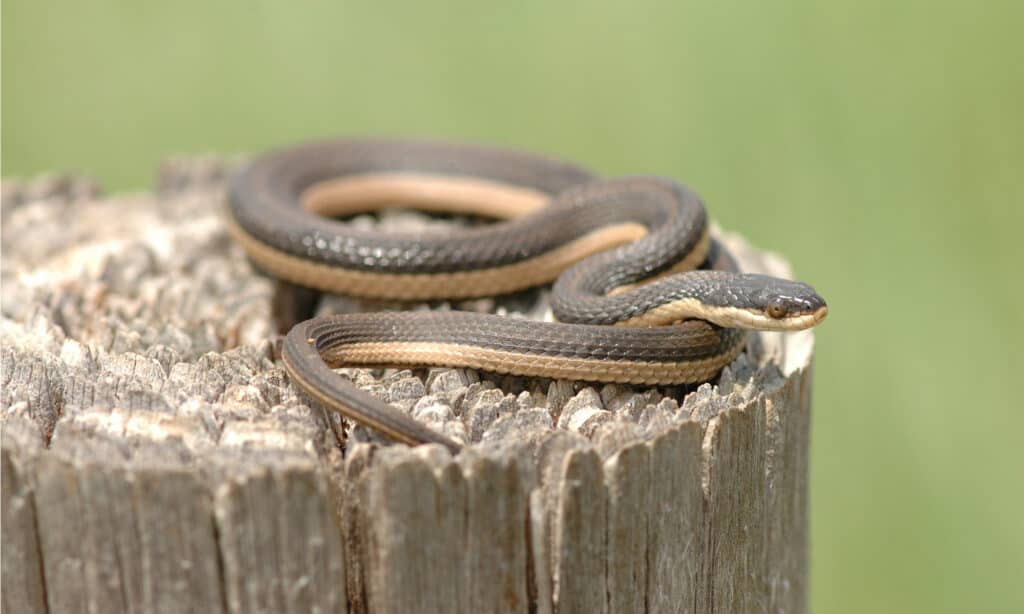
Rusty Dodson/Shutterstock.com
Graham’s crayfish snakes range in color from dull brown to gray to black. They’re two-toned, with copper or tan-colored bellies and solid backs and sides. These snakes don’t grow quite as big as other black snakes in Illinois, maxing out at around two feet long.
Graham’s crayfish snakes are semi-aquatic and live in brackish ponds, lakes, or slow-moving streams. They get their name from their primary food source, the crayfish. Unlike other snakes that eat a variety of foods, Graham’s crayfish snakes eat almost entirely crayfish.
1. Northern Red-bellied Snake (Storeria occipitomaculata)
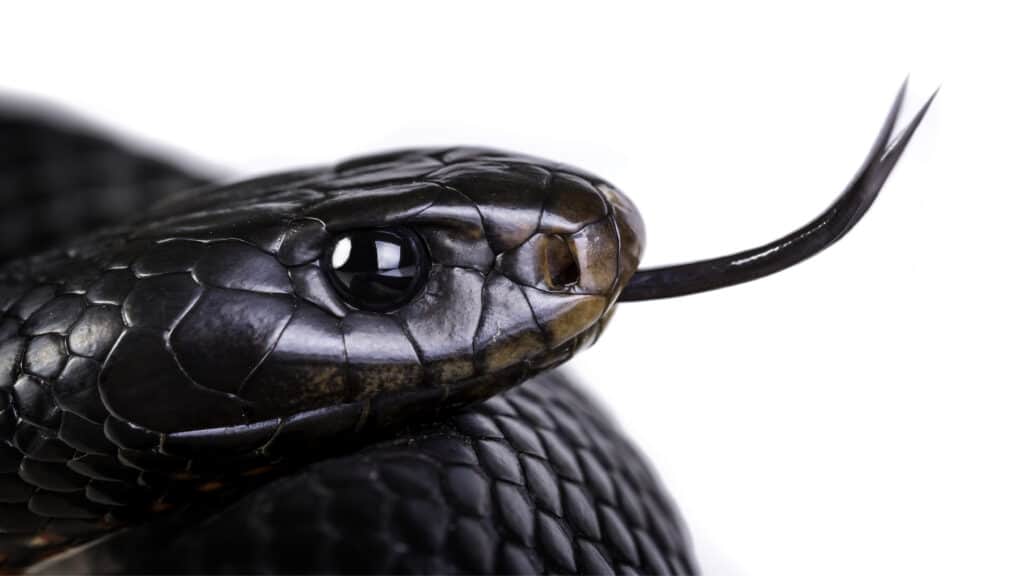
Paul Looyen/Shutterstock.com
Northern red-bellied snakes are one of the smallest black snakes in Illinois at around 10 inches fully grown. They’re solidly colored, with bright red bellies and brown bands just behind their head. They live only in parts of southern Illinois and tend to stick to wetlands or open fields. However, northern red-bellied snakes are also comfortable living in suburban zones.
These snakes are so small that their diet consists mainly of insects like slugs. They’re completely harmless and common to many parts of the eastern United States.
What to Do if You See a Black Snake in Illinois
As with all wild animals, if you see a black snake in Illinois, stay calm, and leave it alone. These snakes are harmless but will bite to defend themselves.
Discover the “Monster” Snake 5X Bigger than an Anaconda
Every day A-Z Animals sends out some of the most incredible facts in the world from our free newsletter. Want to discover the 10 most beautiful snakes in the world, a “snake island” where you’re never more than 3 feet from danger, or a “monster” snake 5X larger than an anaconda? Then sign up right now and you’ll start receiving our daily newsletter absolutely free.
More from A-Z Animals
.more-snake-card-image { max-height:140px !important; }
#mobileSnakeQuizControls { overflow: hidden; text-overflow: ellipsis; white-space: nowrap; }
@media (min-width: 481px) {
.mobile-top-content {
display: none;
}
}
#mobileTopContentCTACarouselControls { overflow: hidden; text-overflow: ellipsis; white-space: nowrap; }
.mobile-top-content .more { color: #fff; }
.mobile-top-content a { color: #fff; text-decoration: underline; }
.mobile-top-content a:hover { color: #fff; text-decoration: underline; }
@media (max-width: 480px) {
.mobile-top-content {
background-color: #06a10b;
color: #fff;
text-align: center;
/*height: 60px;
padding-top:5px;*/
font-size:80%;
/* display: block; */
margin: 0px -30px;
}
}
There are 40 species of snakes currently recognized in Illinois. Of those 40 species, 11 are listed as threatened or endangered. But what about black snakes in Illinois? There are actually seven species of black snakes in Illinois. Like all snakes, these species are cold-blooded and rely on the sun’s warmth to warm their bodies. They range in size from just over a foot long to well over six feet. While none of the black snakes in Illinois have venom, they’re still wild animals and should be respected and left alone.
Let’s take a closer look at the seven species of black snakes in Illinois. Then, we’ll discuss what you should do if you come across a snake in Illinois.
7. Black Racer (Coluber constrictor)

iStock.com/Sunshower Shots
button.pulse {
transform: scale(1); animation: pulse 2s infinite;
box-shadow: 0 0 0 0 rgba(11, 247, 25, 1);
}
@keyframes pulse {
0% { transform: scale(0.90); box-shadow: 0 0 0 0 rgba(11, 247, 25, 0.5); }
60% { transform: scale(1); box-shadow: 0 0 0 15px rgba(11, 247, 25, 0); }
100% { transform: scale(0.90); box-shadow: 0 0 0 0 rgba(11, 247, 25, 0); }
}
Black racers grow up to five feet long and have slender, thin bodies. They’re common throughout the entire eastern half of the United States and even live in Florida. Black racers are sometimes mistaken for black rat snakes or black kingsnakes. They’re almost entirely black or dark gray, with the exception of some white coloring at the throat. Juvenile black racers actually aren’t black snakes in Illinois—they’re light gray with brown patterning.
Black racer snakes live anywhere they can find food. Their favorite prey are birds, rodents, lizards, snakes, and even insects.
6. Ringneck Snake (Diadophis punctatus)

Tom Fenske/Shutterstock.com
Ringneck snakes range in color from gray to black, with yellow to tan bellies. They’re one of the black snakes in Illinois. But, as you might have guessed, they get their name from the brightly colored ring around their neck. Ringneck snakes have yellow bands just behind their heads, but other than that, their backs are all black or gray.
These snakes are so small you might never notice them, with the biggest reaching only 15 inches long. They live just about anywhere they can find small prey, including forests, rocky hillsides, grasslands, or riverine environments. They’re not a threat to humans, though they use a weak venom for hunting prey like mice and lizards.
5. Western Mud Snake (Farancia abacura)

Thesigner_2696/Shutterstock.com
Western mud snakes live throughout the southeastern United States. They’re found only in the extreme southern part of Illinois. Mud snakes spend most of their time in the water, either in swamps, slow-moving rivers, lakes, wetlands, or ponds. They prefer areas with lots of aquatic plantlife to hide in; humans rarely get the chance to see these beautiful, elusive snakes.
Western mud snakes are one of the black snakes in Illinois, but they’re not entirely black. Both adults and juveniles have all black backs, with red to pink bellies and sides. Young mud snakes have bright red, striped bellies, while adults tend more towards pink. These snakes eat mostly amphibians, like salamanders, frogs, toads, and tadpoles.
4. Black Kingsnake (Lampropeltis getula)

Matt Jeppson/Shutterstock.com
Black kingsnakes grow to an average length of 3-4 feet. They’re almost entirely black, except for thin, white bands that run down their bodies. They prefer living in grasslands, shrublands, or areas bordering wetlands or streams. Black kingsnakes aren’t venomous, but that doesn’t stop them from consuming other venomous snakes.
These snakes only occupy the southern half of Illinois. They’re sometimes mistaken for other black snakes in Illinois. But, only the black kingsnake bears the distinctive pale bands around its body.
3. Black Rat Snake (Pantherophis obsoletus)

Matt Jeppson/Shutterstock.com
One of the larger black snakes in Illinois, black rat snakes grow up to six feet long. But don’t be afraid of them—they’re not venomous and have no interest in biting humans. Instead, as you might have guessed from their name, they prey mainly on rodents, like rats and mice.
Black rat snakes live throughout the entire eastern United States. In Illinois, they prefer forests, floodplains, and the margins of suburban areas.
2. Graham’s Crayfish Snake (Regina grahamii)

Rusty Dodson/Shutterstock.com
Graham’s crayfish snakes range in color from dull brown to gray to black. They’re two-toned, with copper or tan-colored bellies and solid backs and sides. These snakes don’t grow quite as big as other black snakes in Illinois, maxing out at around two feet long.
Graham’s crayfish snakes are semi-aquatic and live in brackish ponds, lakes, or slow-moving streams. They get their name from their primary food source, the crayfish. Unlike other snakes that eat a variety of foods, Graham’s crayfish snakes eat almost entirely crayfish.
1. Northern Red-bellied Snake (Storeria occipitomaculata)

Paul Looyen/Shutterstock.com
Northern red-bellied snakes are one of the smallest black snakes in Illinois at around 10 inches fully grown. They’re solidly colored, with bright red bellies and brown bands just behind their head. They live only in parts of southern Illinois and tend to stick to wetlands or open fields. However, northern red-bellied snakes are also comfortable living in suburban zones.
These snakes are so small that their diet consists mainly of insects like slugs. They’re completely harmless and common to many parts of the eastern United States.
What to Do if You See a Black Snake in Illinois
As with all wild animals, if you see a black snake in Illinois, stay calm, and leave it alone. These snakes are harmless but will bite to defend themselves.
Discover the “Monster” Snake 5X Bigger than an Anaconda
Every day A-Z Animals sends out some of the most incredible facts in the world from our free newsletter. Want to discover the 10 most beautiful snakes in the world, a “snake island” where you’re never more than 3 feet from danger, or a “monster” snake 5X larger than an anaconda? Then sign up right now and you’ll start receiving our daily newsletter absolutely free.







